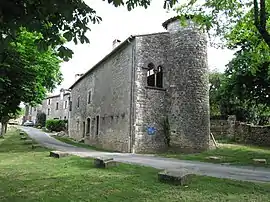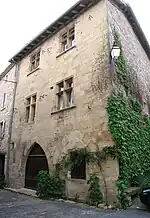Puycelsi | |
|---|---|
 15th-century house in Puycelsi | |
.svg.png.webp) Coat of arms | |
Location of Puycelsi | |
 Puycelsi  Puycelsi | |
| Coordinates: 43°59′38″N 1°42′39″E / 43.9939°N 1.7108°E | |
| Country | France |
| Region | Occitania |
| Department | Tarn |
| Arrondissement | Albi |
| Canton | Vignobles et Bastides |
| Intercommunality | CA Gaillac-Graulhet |
| Government | |
| • Mayor (2022–2026) | Jacques Vigouroux[1] |
| Area 1 | 39.2 km2 (15.1 sq mi) |
| Population | 456 |
| • Density | 12/km2 (30/sq mi) |
| Time zone | UTC+01:00 (CET) |
| • Summer (DST) | UTC+02:00 (CEST) |
| INSEE/Postal code | 81217 /81140 |
| Elevation | 132–367 m (433–1,204 ft) (avg. 280 m or 920 ft) |
| 1 French Land Register data, which excludes lakes, ponds, glaciers > 1 km2 (0.386 sq mi or 247 acres) and river estuaries. | |
Puycelsi (French pronunciation: [pɥisɛlsi], before 2011: Puycelci; Occitan: Puègcèlsi)[3] is a commune in the Tarn department in southern France.
It is a member of the Les Plus Beaux Villages de France ("The Most Beautiful Villages of France") association. It had 449 inhabitants in 2017.[4]
Toponym
The name of "Puycelci", or "Puycelsi" comes from the Celtic "Celto Dun", a wooden fortress built on a hill, or oppidum, later transformed into "Podium Celsium" by the Romans.
History
The village itself was founded in a location close to the ancient prehistoric site by Benedictine Monks from the Aurillac Abbey in the 10th century. It stands high above the right bank of the Vère, which flows northwestward through the commune.
The first castle was dismantled after the Treaty of Meaux-Paris, in 1229, but the village remained a stronghold. Though it was besieged several times in the 13th and 14th centuries, it was reportedly never taken by force.
Until the First World War, the village was quite prosperous, with a population of nearly 2,000 in 1830. Almost abandoned in the 1950s, it has since been restored by its inhabitants and is now listed among the “Most Beautiful Villages of France”.
Puycelsi is featured in the 2016 BBC/France Télévisions wildlife film Wild Tales from the Village.
Notable buildings

- the 14th century ramparts, and the Irissou Gate with its double defensive system
- the St-Roch Chapel, built in 1703
- the 15th-century castle
- 15th-and-16th-century houses, including the town hall
- the 14th-15th-century St-Corneille Church, with classified well-preserved ancient furniture
Demography
| Year | Pop. | ±% p.a. |
|---|---|---|
| 1968 | 535 | — |
| 1975 | 480 | −1.54% |
| 1982 | 442 | −1.17% |
| 1990 | 453 | +0.31% |
| 1999 | 495 | +0.99% |
| 2007 | 491 | −0.10% |
| 2012 | 474 | −0.70% |
| 2017 | 449 | −1.08% |
| Source: INSEE[4] | ||
See also
References
- ↑ "Répertoire national des élus: les maires" (in French). data.gouv.fr, Plateforme ouverte des données publiques françaises. 4 May 2022.
- ↑ "Populations légales 2021". The National Institute of Statistics and Economic Studies. 28 December 2023.
- ↑ Décret n° 2011-311 22 March 2011 (in French)
- 1 2 Population en historique depuis 1968, INSEE
External links